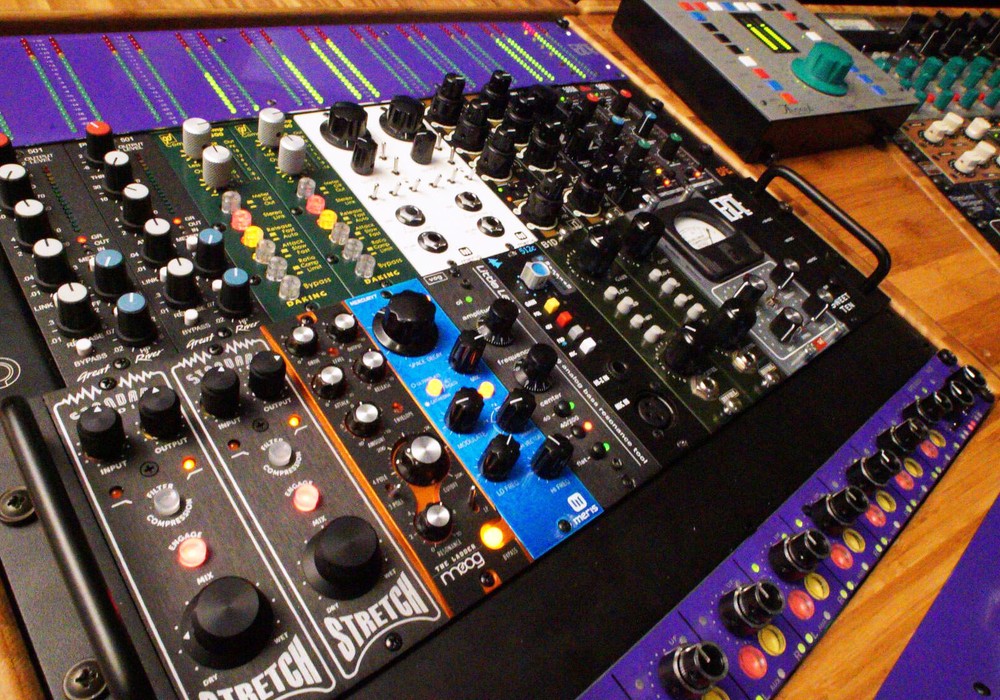So I get home one day to find both an Allen & Heath MixWizard3 16:2 DX and a PA28 waiting for me. Combined with my Mackie 24•8 and the other mixers around the house, this gave me about 90-something channels to work with. Unfortunately, I didn't have a blockbuster pop hit to mix, so I didn't get to set them all up together and pretend I was a bigshot, but the Allen & Heath mixers did see plenty of action.
Both of these mixers are designed with live sound in mind, but the MixWizard3 (or WZ3 for short) is well suited to recording too, and I have to say it is a great little mixer. Specs, briefly: 16 channels with mic/line ins, direct outs, inserts, and phantom power. There's a four-band EQ with a hi-pass filter at 80 Hz and six aux sends per channel. There are no subgroups but there is a dedicated mono out and onboard digital effects.
I put the 16:2 to work as my monitoring console, and it really was a pleasure to use. The board is light and has a small footprint, which keeps it from taking over your space, and makes it easy to move around. When recording full bands, having six aux sends meant I could give everyone an individual headphone mix, which was totally cool and appreciated by all. The preamps didn't sound good when pushed ridiculously hard, but within reason, they were nice. I tried the EQ on all sorts of instruments and found it to be very useable. The high and low bands are shelves at 12 kHz and 80 Hz, and the two mids are sweepable from 35 Hz to 1kHzand500Hzto15kHz.Qisfixedat1.8.TheEQ worked great for getting rid of some low-end murk on kick and bass and for adding a little high end to overhead tracks. Overall, I thought the EQ sounded much better than the EQ on my Mackie. In fact, the WZ3 overall sounds a lot better to me. It's clearer and more open, and it seems like it can be pushed in a more entertaining fashion. While doing rough mixes, I'd been keeping the master-fader at zero like you're supposed to; for fun I decided to see how it sounded all the way up. It was fine. Added a subtle midrange crunch that was pleasant. I decided it wasn't the thing for the song I was mixing, but the mix held up and the low end didn't get all mushy, and it's nice to know there's a sound there if you choose.
I hadn't done a shootout in awhile, so I put the MixWizard3's preamps up against some other affordable preamps I had around. I convinced my lady that testing mic preamps was in fact more fun than going out, set up my AT4050, and she sang a verse of Peggy Lee's "Fever" through the WZ3 preamps, and my Mackie, ART Tube MP, and Bellari MP220 preamps. We used the same cables and converters, and I matched recording and playback levels as best I could. The Allen & Heath preamps were by far the least colored out of the four, and they easily had the most balanced frequency response. The ART and Bellari preamps both sounded hyped in the high end, especially the Bellari. The Mackie preamp just sounded really thin and hard (I'm sorry Mackie-I don't mean to be mean.) The lady liked the ART the best, but I liked the Allen & Heath, and I get to write the review, so the A&H is our winner.
It's been all raves so far, so what didn't I like? Well, the small footprint I'm so fond of also means that the knobs are packed really close together, and even my dainty little fingers could barely get in there to tweak the EQ. No big deal though. It'd be nice to be able to switch the EQ in or out, so you could make quick comparisons between the source and the EQ'ed sound, but this is a minor quibble given the price of the board. My one issue is really more of a request than a complaint, and here it is: POLARITY SWITCHES!
Please! I don't know how much it would cost to include these on every channel, but it would really increase the functionality of the board dramatically. If you're doing any recording that involves more than one microphone, you need the option to flip polarity. You just do. I mentioned using the MixWizard3 as my monitoring board, and I would've tracked through it too if I had been able to flip polarity where necessary. I really think this one thing would make this the perfect board for all of us making records at home on a shoestring budget; it'd make a great front and back end for everyone out there in DAW Nation that can't afford a rack of fancy outboard preamps and a designer summing box.
That's really it; that's my only issue. I haven't talked about the effects yet. They're cool. Long time Tape Op readers with really good memories may recall Chris Walla's fondness for the "cathedral" preset, and I agree; it's the best of the bunch here. The rest are utilitarian reverbs and delays, and it was great to be able to throw some useable "hit sauce" in the headphones so easily when tracking vocals. What's also cool is Allen & Heath's FX Editor software, available via download from their site. Connect a PC to the board via MIDI, and you can edit all of the presets' basic parameters (and more). The software was a breeze to install and worked fine. Besides controls for the effect parameters, there's also a three-band EQ with sweepable mid and a noise gate, both post-effect. As is usually the case, I enjoyed the reverbs a lot more with tons of high end rolled off, so again, a smart design move on Allen & Heath's part. Unfortunately the software is PC- only, so Mac users are out of luck.
On to the PA28. This board features 24 mic/line channels plus two stereo inputs. As I mentioned earlier, it's more of a straight ahead live board than the MixWizard3. There are no direct outputs, and the four- band EQ is a little simpler. (The low-mid is fixed at 250 Hz, while the high-mid is sweepable from 350 Hz to 7 kHz.) There are only two aux sends, but there are two "foldback" sends you can use for monitor mixes, and there's a separate mono output that can be used to feed the subs. One really cool feature is the four-band EQ on the output section. All four bands are sweepable with 10 dB boost or cut, and the EQ can be assigned to either the L/R mix, the foldback mix, or a combination of both. Brilliant. Aside from the main outputs, there's also a stereo RCA out and even an S/PDIF output, and these can both be assigned pre or post master-fader. Like the MixWizard3, the PA28 comes with onboard digital effects, and again these can be controlled via the free software. I really like the way the PA28 is laid out; the channels are wider than those on the MixWizard3, so you have plenty of room to work. The master section is near the middle of the board, which is nice. All the inputs and outputs are at the top of the board, so you don't have to climb around the back and dig out your Maglite to see what you're connecting where. Smart. The manual contains a bunch of really good, solid information on gain staging, using EQ, and applying effects; and as I imagine the board is aimed at the entry-level live market, I felt it was a nice touch to impart some wisdom for folks who may be new to the fiery hellpit that is live sound.
Overall, I think both of these boards are a great bang for the buck. They sound good, have loads of useable features, and are built like tanks. The MixWizard3 streets for about $1000 and the PA28 for $1600. ($1199 MSRP for WZ3 16:2 DX, $1799 for PA28; www.allen-heath.com)





_disp_horizontal_bw.jpg)